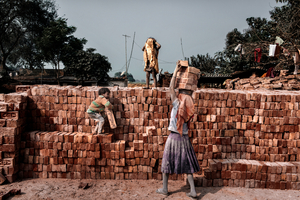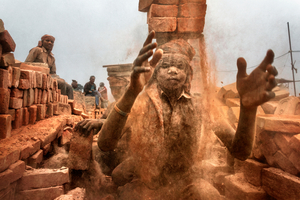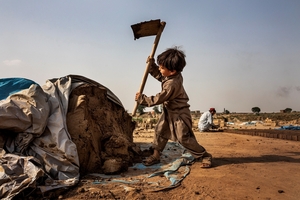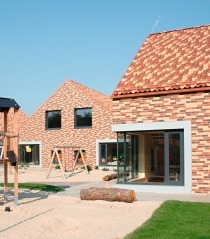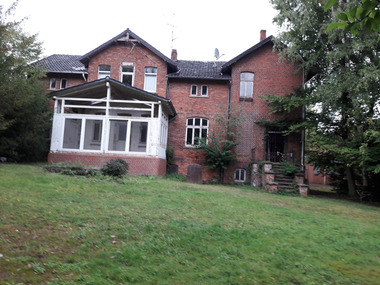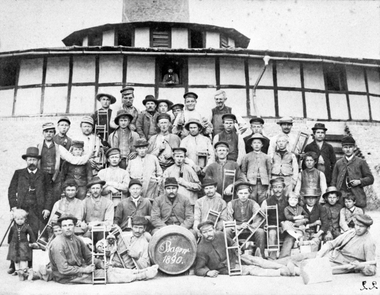Child labour in the brick industry
According to estimates by the United Nations Children‘s Fund (UNICEF) and the International Labour Organisation (ILO), around 54 million children worldwide were working in dangerous and exploitative conditions in 2024. This includes children working in the brick industry. [i] Over the past 17 years, photographer Luca Catalano Gonzaga has taken photos in brick factories in India, Pakistan, Bangladesh, Nepal and Afghanistan as part of a long-term reportage project. His pictures document the living and working conditions of adults and children on site. [ii]
Brick production in South Asia
As in Europe, brick production has a long tradition in South Asia. Fired bricks were already in use in the Indus Valley civilisation, around 3200-1300 BC, in the north-west of the Indian subcontinent.[iii] To this day, the building material remains very popular for a wide variety of buildings. Rapid urban growth and an increased demand for bricks are expected in the region in the coming decades.[iv]
In contrast to production in high-tech industrial plants in Germany, bricks in South Asia are mainly produced by hand.[v] The hard work without adequate safety precautions can have serious health consequences for the workers. The brick-making process involves mixing the clay, shaping the individual bricks using wooden frames, drying the bricks and transporting the dried bricks to the kiln. The bricks are then stacked in field kilns and fired. After firing, they are loaded onto lorries for onward transport to construction companies. Due to weather-dependent production, brickworks can only operate during the dry months, which in India and Nepal are from around November to June. [vi]
Migration and debt bondage
Due to the seasonal nature of the work, the brick industry in South Asia is strongly characterised by interregional and international migration.[vii] Workers come to the brick-making regions with their families only for the production months. During the rest of the year, they usually earn their living as day labourers in agriculture. This makes them part of the poorest rural population.[viii] Often, they are not registered in either their region of origin or the brick-making region. They are therefore not eligible for social benefits.[ix]
Seasonal work means that pay in brick production is also seasonal. As the families are also dependent on wages during the rest of the year, a system of advance payments has developed. Employment agencies give the workers loans and in return they undertake to work off their debts at the brickworks in the following season.[x] Many of the workers cannot read or write properly and have to trust the honesty of the employment agencies when signing the contract. Often, the advance payments can hardly be repaid through work, resulting in so-called debt bondage, which can take very different forms. Debt bondage is a form of modern slavery.[xi]
In some regions of India, debt bondage has long been a normal economic practice in agriculture. After the country‘s independence in 1946, efforts were made to change this. However, it is still commonplace today and has increasingly shifted to the construction sector since the 1990s.[xii] Due to its long tradition, however, the practice is rarely questioned locally.[xiii] The involvement of employment agencies and sub-agencies also makes it difficult to prove illegal debt bondage.[xiv]
It is estimated that around 30 million people worldwide live in modern forms of slavery or debt bondage. Officially, this is prohibited, but there seems to be no political will to combat it.[xv] Although slavery has been well researched in a Western context, there has been little research on regional and global perspectives in Asia to date.[xvi]
Child labour in brick kilns
In order to pay off the debts, it is often necessary for the whole family, including the children, to work.[xvii]
There are no exact figures for the number of children working in the brick industry, as surveys are difficult to conduct. The ILO estimated the number of children working in the brick industry worldwide in 2014 to be around 3.3 million. [xviii] Due to the predicted continued population growth and associated urban expansion, it is unlikely that this number has fallen significantly.[xix] During the brick-making season, families live in temporary huts on or directly adjacent to the brickworks site. Most of the brickworks are located in remote areas and are not connected to the infrastructure of the surrounding towns. This means that children are unable to attend school, or only to a very limited extent. [xx]
Work in the brick factories lasts up to 16 hours a day. The heavy physical labour causes health problems. Workers suffer from respiratory diseases due to high levels of dust and exhaust fumes, as well as back problems due to constant strain. In most cases, there is also a lack of safety precautions and adequate hygiene and medical care.[xxi]
In 1999, the worst forms of child labour were defined in ILO Convention No. 182 and banned. This includes all forms of slavery or slavery-like conditions, forced labour and debt bondage.[xxii] The convention has been ratified by all member states of the United Nations since 2020.[xxiii] In addition, South Asia also has national laws against child labour, debt bondage and exploitation. In practice, however, the regulations are circumvented and offences are not adequately prosecuted.[xxiv]
Enabling education and raising awareness
The main reason for child labour is the precarious living conditions and poverty of families.[xxv] Child labour seems unavoidable for families in order to provide for their basic needs. Added to this is the lack of alternatives, such as accessible schooling.[xxvi] However, child labour is not only a consequence of extreme poverty, it also perpetuates it.[xxvii] An important factor in breaking the cycle of poverty and exploitation is education and the identification of alternative employment opportunities.[xxviii]
Humanitarian organisations are already implementing educational projects in the affected countries. In India, for example, terre des hommes has set up an evening school at a brick factory to prepare children for regular school attendance.[xxix] In Pakistan, the organisation Society for the Protection of the Rights of the Child (SPARC) is actively campaigning against debt bondage and for the rights, healthcare and educational opportunities of workers in the brick industry. To date, the organisation has worked in 120 brick kilns.[xxx] Although child labour has declined worldwide in recent years, it is still part of everyday life for millions of children.[xxxi]


